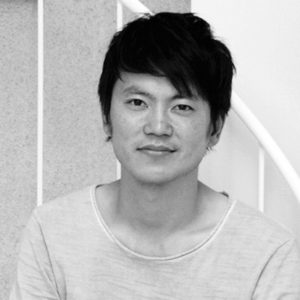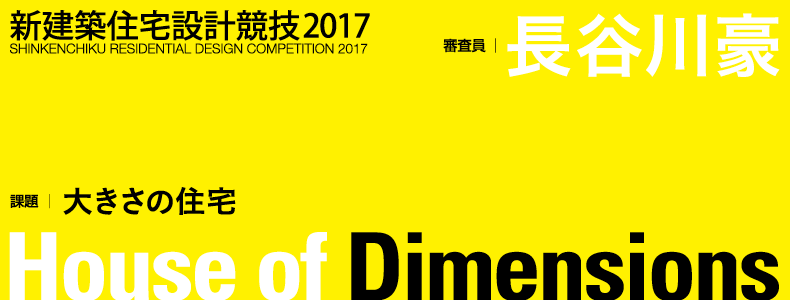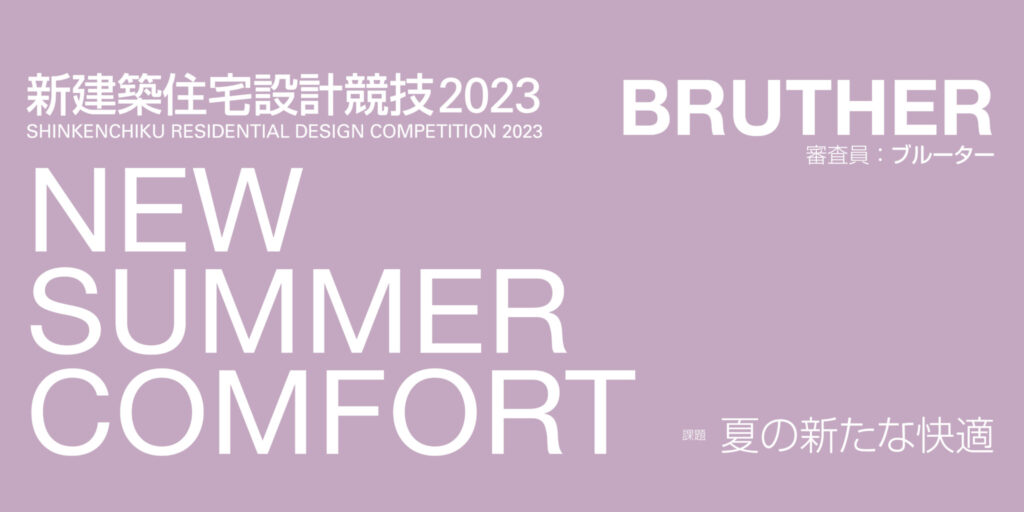新建築住宅設計競技2017 大きさの住宅
テーマ 大きさの住宅
今回のコンペティションのテーマは「大きさの住宅」です。大きさという観点から新たな住宅を構想してください。住宅の大きさは、実にさまざまなことを表象します。
例えば所有者の資産や、その人の住宅に対する価値観を表します。住宅は大きければ大きいほどよいという人もいれば、小さな住宅の美意識を重視する人もいる。あるいは、国や地域によって標準的な住宅の大きさが異なります。日本人が海外に行くと住宅の大きさが倍以上あって驚くことがあったり、昔の住宅を訪れていちばん驚くのもその大きさだったりします。いま僕たちが知っている公共建築よりも大きな住宅など、古今東西を見ればいくらでもある。ひとくくりに「住宅スケール」などと言いがちですが、住宅の大きさは、実に相対的で、それぞれの社会や文化や歴史に深く根ざしているのです。
さて、ここまで住宅の大きさについて書きましたが、今回のテーマは「住宅の大きさ (Size of House)」ではなく、「大きさの住宅 (House of Dimensions)」です。つまり、ただ単に住宅を巨大あるいは極小にしてみるといったように、見たことのない住宅の大きさを提案すればよいということではありません。それだけではつまらない。住宅の大きさなど実に相対的なものだと先ほど書いた通り、設定次第で極端なものはいくらでもできてしまうからです。
ここで求めているのは、いわば「大きさだけで住宅をつくること」です。幅、奥行、高さといった、物理的な空間の大きさの新たな可能性について改めて考えてほしい。あるいは住宅設計ではこれまで到底扱われることのなかったさまざまな「大きさ」について考えてみるのもいいでしょう。自由に、大胆に、構想してください。
「大きさ」の概念そのものを揺さぶる、新たな住宅の提案を期待しています。
賞金
- 入選賞金数点100万円
※入選点数および賞金の配分は審査員の決定に従います。
スケジュール
- 2017年1月31日 (火)登録開始
- 2017年5月9日 (火)応募登録終了
- 2017年10月1日 (日)入選発表
応募要項
参加登録
登録は、専用WEBページ上の登録フォームから行ってください。必要事項を入力すると、e-mailで登録番号が交付されます。この登録番号は応募にあたって必要となりますので、各人で保存してください。登録番号交付後、登録内容に変更が生じた場合は再度登録を行ってください。また、複数の作品を応募する場合は、その都度登録してください。
・交付後の、登録番号に関する問合せは受け付けません。
・応募登録は当WEBページ以外からはできません。
・携帯のメールアドレスでは登録番号通知メールを受け取れない場合があります。提出物
応募作品:寸法420mm×594mm(JIS規格A2)2枚に、配置図、平面図、立面図、断面図、アクソノメトリックまたは投影図、パース、その他設計意図を説明するに必要と思われる図面や、模型写真、グラフなどの図版、設計主旨(英語または日本語で記すこと)などを各自選択して描いてください。
なお、設計主旨は英文250ワード以内でまとめ、12ポイント以上の大きさで応募作品内に記入してください。また、応募メール本文にも同じ設計主旨を記入して提出してください。
・ファイル形式:PDF形式
・ファイルサイズ:合計10MB以下(2枚でひとつのファイルにまとめること)
・ 応募作品提出時に事前に受け取った登録番号を電子ファイルの名前として使用して下さい。
(例:skc0000.pdf)応募方法
登録完了メールで指定されたアドレス宛に以下の形式でお送り下さい。
①メールタイトルは「登録番号(半角英数)/新建築住宅設計競技2019応募案」
②応募作品を添付(ファイル容量にご注意下さい。規定外の作品は審査対象外となります。)
③メール本文には、登録書類:登録番号・応募者全員の氏名、年齢、職業/代表者の住所、電話番号、ファックス番号、e-mailアドレス、設計主旨(250ワード以内)を順に記入してください。
注意)応募締切間際は回線の混雑が予想されます。お早めの応募をお願いします。
なお回線混雑による提出遅れにつきましては対応しかねますのであらかじめご了承下さい。入選発表
入選発表は、月刊『新建築』2017年10月号(2017年10月1日発売)、および月刊『a+u』10月号(2017年9月27日発売)に変更になりました。合わせて、同誌デジタルデータ、当WEBページでの公開を予定しています。
その他
・応募作品の著作権は応募者に帰属しますが、出版権は新建築社が保有します。
・応募作品は入選・選外に関わらず、当WEBページに掲載されることがあります。
・応募要項についての質問は一切受け付けません。要項に書かれている範囲内で応募者が 各自判断してください。
・応募作品は未発表のものに限ります。応募作品の一部あるいは全部が、他者の著作権を 侵害するものであってはいけません。また、雑誌や書籍、WEBページなど、著作物から 複写した画像を使用しないこと。著作権侵害の恐れがある場合は、主催者の判断により入 選を取り消す場合があります。
・受賞作品につきましては、掲載時に新たに応募データを送っていただきます。
・応募に関する費用はすべて応募者が負担してください。
・応募作品は各自で内容を確認の上、お送りください。応募後の作品差し替えは不可とします。
・文字化け、リンク切れにご注意ください。リンクファイルは埋め込みとしてください。
・規約に反するものは受理できない場合があります。
審査委員
長谷川 豪審査委員
1977年 埼玉県生まれ
2002年 東京工業大学大学院修士課程修了
2002〜2004年 西沢大良建築設計事務所
2005年 長谷川豪建築設計事務所設立
2012〜2014年 メンドリジオ建築アカデミー客員教授
2014年 オスロ建築デザイン大学客員教授
2015年 東京工業大学大学院博士課程修了(工学博士)
2016年 カルフォルニア大学ロサンゼルス校客員教授
現在,ハーバード大学デザイン大学院客員教授
総評
Competition 2017 Ideas and Dimensions: Go Hasegawa

Go Hasegawa Jury Member
A house that updates a very common concept of “dimensions,” which is the theme of this competition.
It is probably one of the first words for a young child to learn and use “big/small.” The concept of “dimensions” is so common for the human being although it is quite ambiguous at the same time. Such ambiguity can be understood since the criteria for what is “big/small” vary according to the situation. Something “big” for a person can often be considered as something “small” for another. Even the human scale that is considered as “the absolute scale of measurement” cannot be so absolute when you closely observe the difference in, for example, bodies of Japanese and Westerners. As I mentioned in the competition assignment, the concept of “dimensions” deeply relies on a place (difference in regions and cultures), time (difference of eras), and person (difference in perspectives). It means that the concept of “dimensions” reflects cultural differences as well as social circumstances of the time. In other words, developing a house with a brand-new concept of “dimensions” can possibly make a difference in current cultural and social circumstances. That is what I expected to see in this competition.
While the theme “dimension” is common for everyone and it’s easy to develop an idea from that, I was still a bit anxious about how many entries we would receive until we saw the total of 1,081 registrations (614 domestic, 467 overseas) and 418 submissions from all over the world. It turned out to be an exceptionally international design competition with history. Reviewing all PDF files took much longer than I expected, partly because I was not accustomed to it, and also partly because it was very difficult to decide prize winners among a large number of excellent pieces.
Damjanović won the first prize with the proposal that focuses on and deals with cultural differences in “dimensions.” The house is on the border, and its elements are placed randomly. Sizes and shapes of these elements reflect various cultural differences. According to its descriptive text, a column, for example, can become a bench, a chapel, a well, or a shower stall as it changes in size. Drawn from the migrant crisis as a present-day social issue, this is a house that doesn’t solve such issues but naturally accept various cultural differences with its “various dimensions.” Diversifying “dimensions” can be a methodology to accept human diversity as it is. I found such perspectives of “various dimensions” very attractive. Moreover, its presentation was superbly effective by using a couple of drawings that represent the image and history of migrants in contrast. The only thing that I should be critical about this was the title “collage house” (is it an homage to Collage City by Colin Rowe?). It would have been much better if it could go beyond a mere collage and represent the world in the age of globalization as the proposal intends to show. Nevertheless, Damjanović surely deserves the first prize.
Shiihashi won the second prize with a challenging idea of a house addressing dimensions of a gender issue, which reflects the “social gender gap” becoming narrower and narrower in the current society. (Letting alone whether gender gap can be narrower to such an extent or not.) A space is divided by the center wall, creating two mirror image rooms; one for a male and the other for a female. The only place where the gender difference is obvious is on a bed, ironically placed in an asymmetrical manner. This really made me laugh. While many entrants tried very hard to manipulate physical dimensions such as height or size, Shiihashi’s proposal offers a unique and unexpected perspective of “dimensions,” the theme of this competition, and it can be highly evaluated that such perspective was neatly realized in the design of space. What disappointed me was that the image of its model being shot a little overexposed brought me an intense deja vu. I suppose there would have been a cleverer and more appropriate representation for this idea.
EQUAL HOUSE by Chang+Manthripragada stood out from those dealing with physical dimensions, and thus won the third prize. The idea is very simple, with the table, kitchen island, bathtub, and bed that are exactly identical in size. Different elements in the same dimensions visualize deviation in those supposedly identical spaces. This proposal captured the relativity of “dimensions” well among those eccentric ones that brought extreme dimensions into a house. Their simple and crisp presentations with only one sentence was also favorable. Roh+Kim+Park won another third prize by the proposal of a share house where not only humans but also animals in different sizes coexist. Although there were similar approaches that a house represented a broader ecosystem, density of this proposal was outstanding among them. The image of 21 kinds of different “dimensions” in a complete harmony created a great impact while it might have been better that dens of different animals were re-created into a brand-new house rather than presented them as a collage.
Ito received an honorable mention with a proposal of a house that the sound echoes equally in every room. While a tower-type house and a one-story house shown as its variations are too schematic, the way it represents “dimensions” is quite interesting. I would say that the idea could be developed further and it made me want to walk around in such a house and feel the sound. Montresor+Lando made a proposal that minimum elements were placed as a house in the great nature of California, and I had sympathy with their idea that scales of the human body and the nature were practically connected without using “dimensions of an architecture.” It would have been even more preferable if they could have integrated fragmented ideas into a larger image. Constructing elevation surfaces of a collective housing with large and curved balconies was a proposal by Yamaguchi. Its approach for reconstructing a residence from the perspective of “dimensions of a cluster” should be recognized even though the presentation was a little too descriptive and the drawing lacked some impacts. Hatakeyama’s proposal focused on the distance to the sky and it was presented by a ceiling with its thickness changed from extremely thin to extremely thick. It is a pleasant idea with an attempt to address the space by its quality where it is hard to grasp only by its visual perception, though the interesting point of the proposal seems to be replaced with the “weight” of overhead mass rather than its “dimensions.” Kawamoto’s proposal had a clear idea of the mixture of various “dimensions,” and its delicate drawing was quite impressive. However, I would call it “scaleless” rather than “no scale”, since trees are the metaphor for it. Another impressive drawing by Zhang showed a house that is only one-dimensional with the depth, and residents would live there along lines. The concept of one-dimensional house is very interesting, but I’d like to see the deeper meaning of what would happen by such a concept.
Lastly, looking back the process of reviewing all entries, I gave up to examine PDF files on iPad after I narrowed down the entries to the best fifty proposals. Instead, I decided to print them out although it was not an easy task to do at my office. The reason why I did it was that it became harder and harder for me to review them objectively with the PDF data on the screen, even though it could be scalable and I could examine as much detailed information as possible by spending time for the review. It may be just my issue, or I may eventually get used to it. This competition specified the “dimension” of submission data: A2 size (420×594 mm / 16.5×23.5 inches) in PDF format. I therefore imagined that entrants actually did print out their proposals to check the “dimension” at least once before they submitted them. When I arranged the printed out papers on the desk, I felt a strong response from them. Some proposals that I was not so attracted on iPad screen became to look outstanding, and vice versa. I was even surprised to see the result changed so dramatically.
An idea itself may be just information, but as soon as it obtains a specific “dimensions,” it starts to face to the real. Even a wonderful idea could be spoiled by wrong “dimensions.” The moment when “dimensions” are given to an idea could be when architecture is created.

